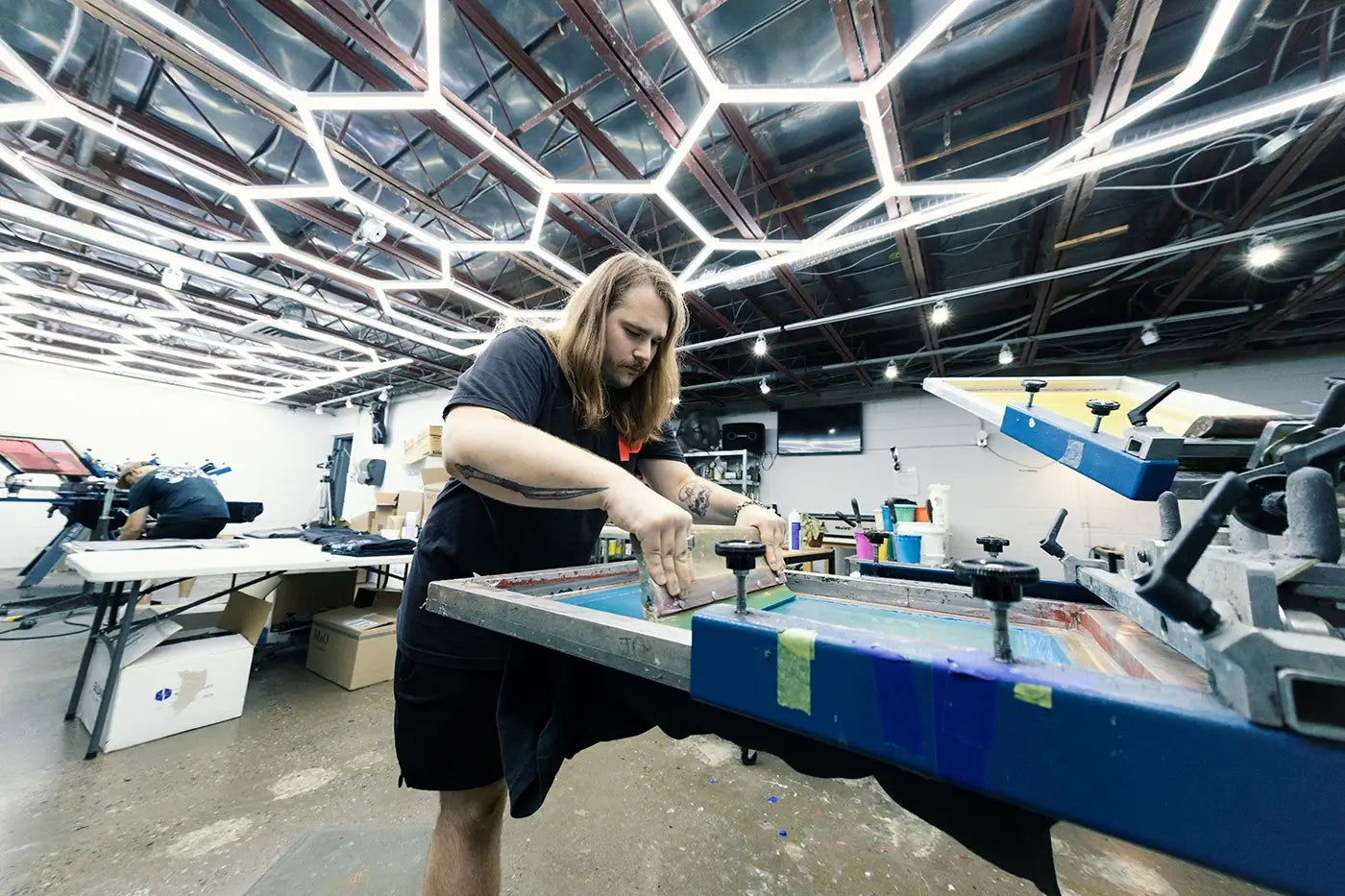Custom Screen Printing for Unique Promotional Merchandise
Custom Screen Printing for Unique Promotional Merchandise
Blog Article
Display Printing Uncovered: Everything You Required to Learn About T-Shirt and Garment Printing Strategies
If you've ever before wondered how those vivid designs wind up on your favorite tees, you're in the best area. Display printing is a remarkable method that combines art with technique, providing endless opportunities for creativity. Understanding the fundamentals, from devices to ink options, can significantly influence your results. All set to discover the vital elements that make screen publishing an art type? Allow's uncover the information that can elevate your jobs.
The Basics of Display Printing: Just How It Functions
When you plunge into screen printing, you'll uncover it's both a science and an art. At its core, display printing entails producing a stencil, or display, that allows ink to travel through just in details areas (screen printing kit). You begin by picking your design and preparing your display with a light-sensitive emulsion. When you subject this solution to light, it sets, leaving your style as an unfavorable room.
Next, you'll mix your inks and prepare your printing surface area. Position the screen over the textile, after that utilize a squeegee to push ink via the display onto the garment. This procedure requires accuracy, as you desire clear, vibrant prints. After printing, you'll treat the ink with heat, ensuring it abides by the fabric and lasts through cleans. Each step is crucial, and grasping them will boost your screen printing skills, transforming easy garments right into unique, expressive pieces.
Sorts Of Display Printing Strategies
When you understand the fundamentals of screen printing, it's time to explore the numerous techniques that can elevate your layouts. One popular method is traditional screen printing, where ink is pressed via a stenciled screen.
An additional choice is plastisol printing, recognized for its longevity and vivid shades, making it a preferred for numerous brand names. Experiment with halftone printing to produce slope effects and elaborate styles.
Necessary Tools for Screen Printing
To achieve spectacular cause display printing, having the right equipment is basic. Initially, you'll need a sturdy display printing structure, which holds the mesh that transfers your style onto the garment. Next, invest in top quality mops; these are essential for using ink equally across the screen. You'll also need an excellent direct exposure unit to produce your screens, along with a washout booth for cleansing them after usage. A trusted warm resource, like a conveyor dryer or warmth press, is essential for treating your prints to assure longevity. Do not forget a proper workspace, equipped with tables and storage for your materials. Safety gear, such as handwear covers and masks, will maintain you risk-free from chemicals and inks. With the right devices, you'll be well on your way to generating professional-quality prints.
Selecting the Right Inks and Materials
When selecting inks and products for screen printing, you require to consider the kind of ink that works finest for your task. Think about textile compatibility to assure your styles look excellent and last long. Check out green ink choices to make your printing procedure a lot more sustainable.
Kinds Of Display Inks
Selecting the ideal screen ink is necessary for achieving dynamic, long lasting prints that satisfy your task's requirements. There are several sorts of screen inks to examine. Plastisol ink is prominent for its convenience and ease of use, offering exceptional shade opacity on dark textiles. Water-based ink, on the other hand, supplies a softer feel and is environment-friendly, making it ideal for those wanting to decrease their ecological effect. Discharge inks remove color from the material, resulting in a soft, classic appearance however call for details handling. Ultimately, specialized inks, such as glow-in-the-dark or metallic, can include distinct results to your layouts. Review your project demands and pick the ink that straightens finest with your desired result.

Textile Compatibility Considerations
Recognizing fabric compatibility is crucial for attaining top notch display prints, specifically because various products respond uniquely to numerous inks. When picking inks, take into consideration the material kind-- cotton, polyester, or blends. For cotton, water-based inks work well, supplying gentleness and breathability. Polyester, on the other hand, frequently needs plastisol inks for far better bond and lively colors. If you're publishing on blends, you may need to utilize a combination of both types. Constantly check your inks on example textile to assure they stick properly and preserve shade stability. Furthermore, bear in mind that textile weight and texture can affect the final outcome, so choosing the appropriate ink and product combo is crucial for your project's success.
Eco-Friendly Ink Options
Green inks are coming to be a preferred selection for display printers that wish to visit our website minimize their ecological influence while preserving top quality. When choosing inks, take into consideration water-based inks, which are less damaging and simpler to tidy Check This Out up contrasted to typical solvents. These inks bond well with materials, delivering vibrant outcomes without harmful chemicals. You may also discover eco-solvent inks that use fewer unstable natural substances (VOCs), making them a much safer option for both your health and wellness and the world.
Additionally, seek inks made from renewable energies, such as soy or vegetable-based alternatives. By choosing the right inks and materials, you'll not just create sensational designs but additionally add to an extra lasting printing procedure. Make the switch, and your prints will mirror your commitment to the setting!
Preparing Your Layout for Screen Printing

File Layout Needs
To ensure your layout looks sharp and vibrant on material, you'll require to pay close attention to file layout requirements for display printing. Make certain your layout has a clear background to stop unwanted white sides on your prints. Keep shade settings in mind; CMYK is basic for display printing, so convert your RGB makes as necessary.
Color Separation Methods
Color splitting up is a vital step in preparing your design for display printing, and grasping it can significantly enhance your print top quality. You'll need to break your style into individual colors, as each color needs a separate display throughout printing. Beginning by determining all the shades in your design and create layers each. You can utilize software like Adobe Photoshop or Illustrator to separate and separate colors efficiently. Be specific to conserve each layer as a different data, generally in a format like TIFF or PSD. This precision not just assures accurate shade representation yet also streamlines the printing process. By taking notice of color separation, you'll attain expert and vibrant lead to your screen-printed garments.
Resolution and Size
Achieving the very best outcomes in screen printing starts with ensuring your layout has the appropriate resolution and dimension. Ideally, your art work ought to go to least 300 DPI (dots per inch) for sharp, clear prints. Your last item might look pixelated and unprofessional. if you make use of reduced resolution.
When it pertains to size, think about the dimensions of your print area. Layout your art weblink work to match the last print size, preferably developing it in the real measurements you'll be printing. By doing this, you'll avoid any type of unforeseen scaling problems.
Constantly examine your design in both vector and raster layouts. Vector graphics can be scaled without shedding high quality, making them perfect for display printing. Preparing correctly will guarantee your layout looks amazing on every garment!
Step-by-Step Display Printing Process
Display printing is a dynamic procedure that enables you to produce lively layouts on numerous surfaces. To obtain started, you'll require a screen, solution, and your selected ink.
After rinsing the unexposed solution, your screen prepares. Set it up on your printing surface area and align your garment beneath it. Pour ink onto the screen and utilize a squeegee to push the ink through the pattern onto the material. Raise the display very carefully and allow the print dry. Heal the ink making use of warm to guarantee sturdiness. That's it! You've effectively display printed your layout.
Tips for Successful Display Printing Projects
While you're diving right into your screen printing tasks, keep in mind that preparation is crucial to success. Start by collecting all your materials-- inks, garments, mops, and displays. A tidy workspace assists protect against unwanted mistakes, so clean prior to you begin.
Following, verify your artwork is high-resolution and correctly sized for your garment. Evaluate your display for correct exposure and clean it thoroughly to prevent spots. When blending your inks, follow the supplier's standards to achieve the right uniformity.
During printing, use also pressure with your squeegee for regular outcomes. Don't hurry; take your time to verify each print satisfies your requirements. After printing, let your garments dry entirely before taking care of or packaging them.
Lastly, always keep a sample of your help future recommendation. This means, you can evaluate your progress and enhance your methods gradually. Happy printing!

Regularly Asked Concerns
How much time Does It Require To Set up a Screen Printing Job?
Establishing up a screen printing task normally takes around thirty minutes to an hour. You'll prepare the screens, mix inks, and readjust the press. The time varies based upon complexity and experience, so stay organized!
Can I Publish on Various Material Enters Making Use Of the Exact Same Method?
Yes, you can publish on various textile types utilizing the same method, however you'll need to readjust your inks and settings. Some materials soak up ink differently, so experimenting assurances the best outcomes for each and every material.
What Are Common Errors to Stay Clear Of in Screen Printing?
When display printing, prevent common mistakes like making use of the incorrect ink, neglecting appropriate direct exposure times, or avoiding pre-press checks. Always test your arrangement and keep tidy displays to assure high quality results each time.
How Can I Properly Clean and Maintain My Screen Printing Equipment?
To appropriately tidy and keep your display printing equipment, you should routinely wash screens with proper solvents, examine mops for wear, and guarantee all devices are kept dry and dust-free. Consistency improves and protects against expensive repair work performance.
Is Display Printing Eco-friendly Contrasted to Various Other Approaches?
Screen printing can be more eco pleasant than other approaches, especially if you utilize water-based inks and eco-conscious products. By choosing sustainable products and methods, you lower waste and lessen your effect on the planet.
Display Printing Uncovered: Every Little Thing You Required to Know Concerning T-Shirt and Garment Printing Techniques
At its core, screen printing involves developing a pattern, or display, that permits ink to pass with only in details areas. Placement the display over the fabric, after that make use of a squeegee to push ink via the screen onto the garment. One preferred technique is standard screen printing, where ink is pushed through a stenciled display.When selecting inks and products for screen printing, you need to take into account the kind of ink that works best for your job.
Report this page